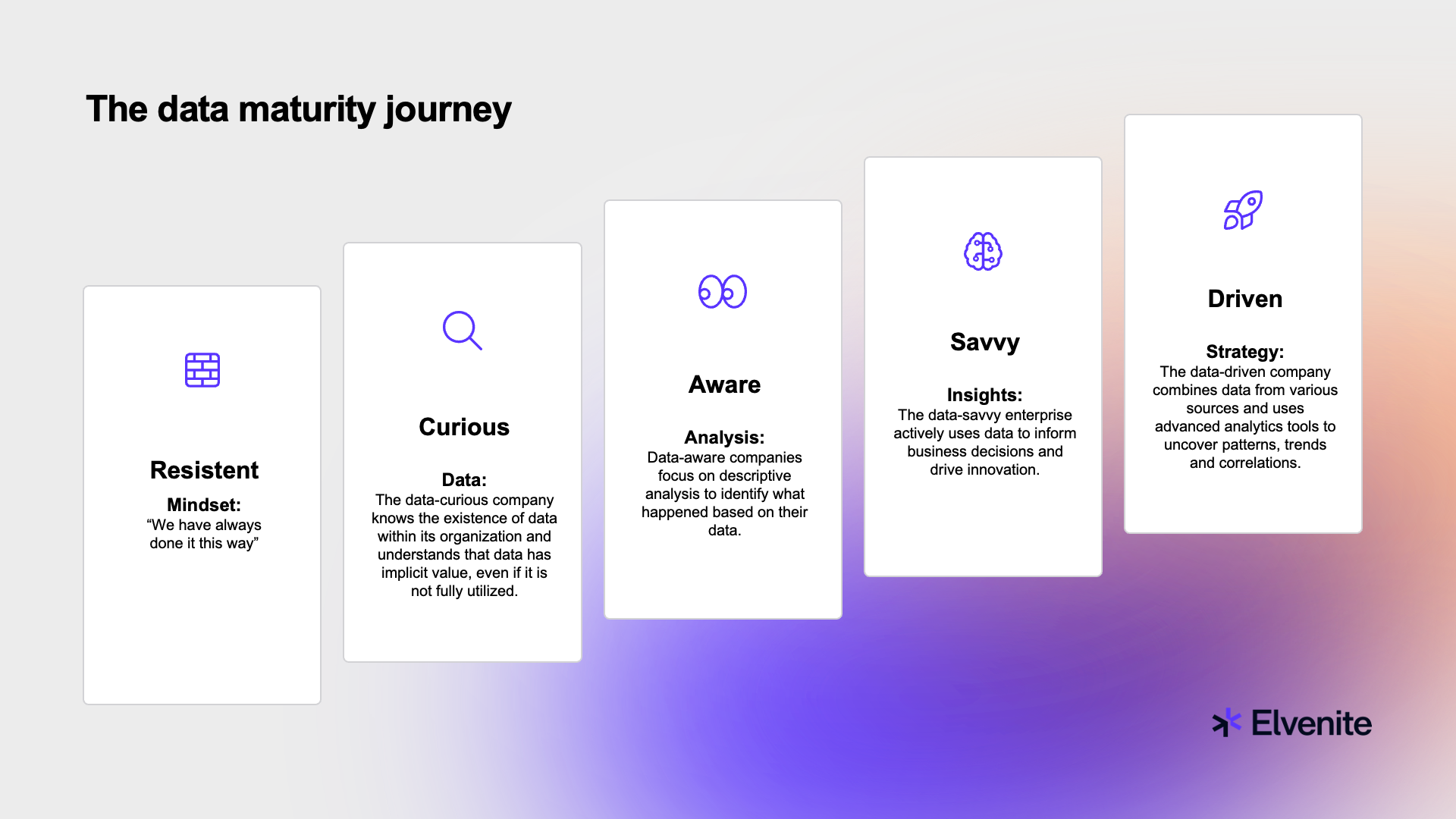Data strategy: what it is, why it’s important and how to get started
3 minutes reading
A data strategy shows how you should collect, manage, analyse and use data so that it actually helps you achieve your business goals. It is your map from raw information to business benefit. At Elvenite, we help you create a clear roadmap with the initiatives and capabilities you need to become data-driven, and we also have the expertise to realise it. Our experts in data management, analysis and system integration lead and execute the projects that make the strategy a reality.

How we help you create a data strategy
A data strategy should not exist in a vacuum. It must be clearly linked to the business strategy. Our experience is that the more data-driven organizations become, the easier and more efficient they can achieve their goals.
To succeed, we need to understand both visions and challenges. Therefore, we work from a framework that combines interviews, workshops, and a structured process. The result is a roadmap that shows the way to real change.
Our method for creating a modern data strategy:
- Data strategy assessment – a current state analysis where we assess data maturity, strengths, and gaps.
- Data strategy workshop – interactive sessions where we, together with management and key personnel, identify and prioritise use cases that provide the greatest business value.
- Roadmap & implementation – we develop a concrete roadmap and ensure it becomes a reality.
Data strategy assessment
We start with a data strategy assessment, a current state analysis where we map data maturity, strengths and gaps. Here we also identify organisational barriers, knowledge gaps and technical prerequisites. It provides a clear picture of where the organisation stands and what steps are needed going forward.
Data strategy workshop
After the current state analysis, we lead data strategy workshops with management and the business. Here we capture both visions and practical needs and translate them into strategic directions.
Example: If a priority goal is to improve production planning in relation to sales, a direction could be "Balance supply and demand".
The strategic directions then serve as signposts. All initiatives and priorities we propose are mapped against these directions, ensuring that the data strategy drives towards business goals.
Roadmap & implementation
In the final step, we translate the directions into a concrete roadmap. It describes which initiatives should be implemented, in what order and with which dependencies.
The roadmap becomes a practical plan to achieve business goals. We also stay involved in the implementation – from establishing platforms and governance to integrating data sources and building new ways of working so that the strategy truly leads to results.
From strategy to implementation
Creating a data strategy is just the beginning, the value comes only when it is put into practice. That’s why we operate as both data strategy consultants and long-term data strategy partners.
In the implementation, we help with:
- Anchoring the strategic directions in the organisation.
- Building governance, processes, and roles.
- Implementing platforms and integrating data sources.
- Training and developing a data-driven culture.
In this way, the data strategy becomes not a document that collects dust, but a living part of business development.
Where is your company on the path to becoming data-driven? With our model, we identify the current situation, set the direction, and help you take the step towards a business where data drives decisions.
Examples of successful data strategy projects
We have worked with organisations at very different stages of their data journey – from those that are already underway to those that are starting from scratch.
The coffee company
The company already had some (data) BI usage in the form of reports and dashboards, but lacked a clear overall picture. Data was scattered, KPIs (and business logic) were defined in different ways in different parts of the organisation, and much of the analysis was still done manually in Excel.
With the help of a data strategy, they were able to:
- Agree on common KPIs and definitions.
- Implement a modern analytics platform that made data more accessible and usable.
- Get a clear roadmap showing which initiatives should be prioritised to take the next step towards a data-driven culture.
The logistics company
As a newly formed company, they had no established ways of working with data. They lacked both structure, governance, and a plan for how data could support business goals. At the same time, the need was great, from following up on customer relationships to optimising logistics flows.
Here, we helped to:
- Build their very first data strategy from scratch.
- Identify which data sources were most important to start with.
- Create a framework for how they could grow incrementally and become more data-driven over time.
Regardless of whether the starting point is fragmented follow-up or a total lack of strategy, a clear data strategy makes the difference between groping in the dark and steering the organisation using data.
Join 43 other companies - create your data strategy with Elvenite
FAQ
Frequently asked questions about data strategy
A data strategy is a plan for how a company collects, manages, analyzes, and uses data to achieve its business goals. It connects technology, processes, and people to make data a strategic asset — not just an IT initiative.
Without a clear data strategy, organizations risk creating data silos, poor data quality, and inefficient workflows. A well-defined strategy ensures that data is used to make better decisions, increase efficiency, and create measurable business value.
The right time is now - especially if your organization has a lot of data but no clear structure for using it. A data strategy helps you prioritize the right initiatives before investing in tools or technology.
A strong data strategy includes business goals, data collection, storage, analysis, governance, organization and skills, and technology. Together, these elements create the foundation for using data in a sustainable and value-driven way.
Start by defining what you want to achieve with data and which business challenges you aim to solve. Then assess your current state — data, systems, and skills — and create a roadmap outlining how to implement and realize your strategy step by step.
Related news

Swedish Match Industries takes the next digital step with Elvenite and Infor CloudSuite

Snellman goes live with Infor CloudSuite in collaboration with Elvenite


